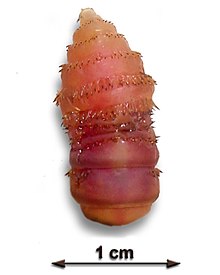Stomach dasseln
| Stomach dasseln | ||||||||||||
|---|---|---|---|---|---|---|---|---|---|---|---|---|

Gasterophilus intestinalis |
||||||||||||
| Systematics | ||||||||||||
|
||||||||||||
| Scientific name | ||||||||||||
| Gasterophilinae | ||||||||||||
| Girschner , 1896 |
The gastric dasseln or gastric brakes (Gasterophilinae) represent a subfamily of the botflies (Oestridae). The larvae of the animals are parasitic and, like the other botflies, predominantly infect ungulates , especially horses. They mainly develop in the stomach of their host animals.
features
The adult flies are medium-sized and mostly furry hair. The wings are very well developed and the animals are good fliers. In flight they emit a distinctive humming sound, which already disturbs their potential hosts and triggers flight instincts. The mouthparts of the stomach are receded and the animals do not eat any food as adults. Their lifespan is accordingly very short with one to seven days.
Occurrence
About 25 species of the gastric dasseln are known worldwide, 10 of them are to be found in Europe.
Reproduction
The mated females of the gastropods fly to their victims and lay the eggs in the fur and stick them together there. The most common European species, the horse gizzard ( Gasterophilus intestinalis ) prefers the chest and stomach area or the legs, other species lay eggs near the mouth and Gasterophilus pecorum also chooses objects near the horses to lay eggs . In some species, the female lays up to 5,000 eggs, but most species lay fewer.
Development cycle
The larvae hatch after about a week, the larvae of Gasterophilus intestinalis only after contact with the saliva of the host animal. The young larvae then penetrate the oral cavity and hook onto the tongue or cheek with the mouth hooks. From here the maggots migrate into the throat and settle under the epiglottis. Here they begin their blood meal, in the course of which they migrate to the stomach and intestines and hook themselves there with the help of wreaths of thorns. A characteristic feature of the larvae at this stage are hemoglobin-containing fat cells, which are clearly visible through the white body. With these, the larvae are able to bind oxygen very effectively , although they can do without it entirely. The stomach of the infected horse can contain several hundred of these parasites. The mature larvae leave their host through the anus and pupate in the ground.
Harmful effect
The gasterophilinae parasitize almost exclusively in perissodactyls , thus with horses , donkeys or mules , the genus Gyrostigma even with rhinos . They are also less common in dogs and also in humans and are referred to here as “skin moles” because they eat their way under the skin. However, development is not completed in these false hosts and the larvae perish in the second larval stage.
Phylogeny, taxonomy, systematics
For a long time, the Gastendasseln were considered an independent family; today the classification as a subfamily of the family Oestridae has prevailed. The subfamily comprises three to five genera, depending on the taxonomic view. The position of two monotypical (only consisting of one species) genera is controversial : Ruttenia loxodontis Rodhain lives in skin bumps (same bumps), Neocuterebra squamosa Grünberg in pockets in the skin tissue of African elephants ( Loxodonta africana ). Both are basal lines closely related to the Gasterophilinae, in which they are included by some authors. Usually these, poorly examined, species are placed in separate subfamilies Rutteniinae or Neocuterebrinae. The remaining (core) Gasterophilinae form a monophyletic unit. They comprise three genera:
- Genus Gasterophilus ; Parasites in horses, eight species.
- Genus Gyrostigma ; Parasites in rhinos, three types.
- Genus Cobboldia ; Parasites in elephants, three species (another, Cobboldia rusanovi Grunin, died out together with its host, the woolly mammoth ).
Genetic studies of the MtDNA show the following relationships:
| Gasterophilinae |
|
||||||||||||
|
|
literature
- Joachim Haupt, Hiroko Haupt: Flies and Mosquitoes. Observation, way of life. Natur-Verlag, Augsburg 2001, ISBN 3-89440-278-4
- Klaus Honomichl, Heiko Bellmann : Biology and Ecology of Insects , (1 CD-ROM), Fischer, Stuttgart 1996, ISBN 3-437-25020-5 (Book edition: Fischer, Stuttgart 1998, ISBN 3-437-25890-7 )
Individual evidence
- ↑ F. Zumt & H. Wetzel (1970): Fly parasites (Diptera: Oestridae and Gasterophilidae) of the African Elephant (Loxodonta africana Blumenbach) and their problems. Koedoe 13: 109-121.
- ^ T. Pape: Phylogeny and Evolution of Bot Flies. Chapter 3 in Douglas D. Colwell, Martin JR Hall, Philip J. Schol (editors): The Oestrid Flies: Biology, Host-parasite Relationships, Impact and Management. CABI Publishing, Wallingford, 2006. ISBN 978-0-85199-684-4 .
- ↑ Liping Yan, Thomas Pape, Mark A. Elgar, Yunyun Gao, Dong Zhang (2019): Evolutionary history of stomach bot flies in the light of mitogenomics. Phylogenomics Virtual Issue (9th Dresden Meeting Insect Phylogeny, September 20-22, 2019). doi: 10.1111 / syen.12356 (open access)
